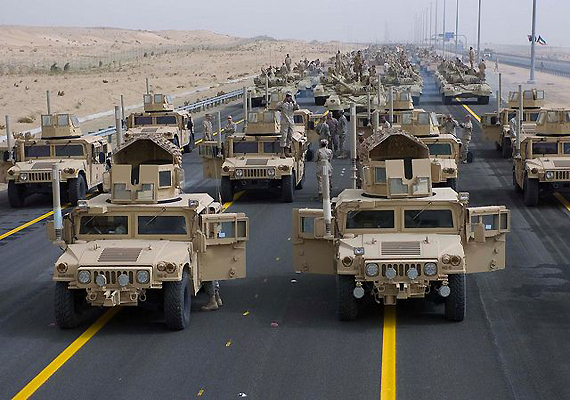The United States is planning a significant military presence of 15,000 troops in South Kuwait to give it the flexibility to respond to sudden conflicts in the region.
 The United States is planning a significant military presence of 15,000 troops in South Kuwait to give it the flexibility to respond to sudden conflicts in the region.
The United States is planning a significant military presence of 15,000 troops in South Kuwait to give it the flexibility to respond to sudden conflicts in the region.
The study by the Senate Foreign Relations Committee examined the U.S. relationship with the six nations of the Gulf Cooperation Council - Saudi Arabia, Kuwait, Bahrain, Qatar, the United Arab Emirates and Oman - against a fast-moving backdrop. In just the last two days, Saudi Arabia's ruler named Defense Minister Prince Salman bin Abdul-Aziz as the country's new crown prince after last week's death of Prince Nayef, and Kuwait's government suspended parliament for a month over an internal political feud.
"Home to more than half of the world's oil reserves and over a third of its natural gas, the stability of the Persian Gulf is critical to the global economy," the report said. "However, the region faces a myriad of political and security challenges, from the Iranian nuclear program to the threat of terrorism to the political crisis in Bahrain."
The report obtained by The Associated Press in advance of late Tuesday's release provided precise numbers on U.S. forces in Kuwait, a presence that Pentagon officials have only acknowledged on condition of anonymity. Currently, there are about 15,000 U.S. forces in Kuwait at Camp Arifjan, Ali Al Salem Air Base and Camp Buehring, giving the United States staging hubs, training ranges and locations to provide logistical support. The report said the number of troops is likely to drop to 13,500.
Instead, officials talked of positioning a strong U.S. force just across the border in Kuwait. The strategy preserves "lily pad" basing that allows the military to move quickly from one location to the next.
As it recalibrates its national security strategy, the United States is reducing forces in Europe while focusing on other regions, such as the Middle East and Asia. Defense Secretary Leon Panetta has said he envisions about 40,000 troops stationed in the Middle East region after the withdrawal from Iraq. By comparison, a cut of two Army combat brigades and the withdrawal of two other smaller units will leave about 68,000 troops in Europe.
During the 1991 Gulf War, some half a million U.S. forces were in the Middle East region. The United States maintained about 5,000 troops in Kuwait from the end of the Gulf War to March 2003, when U.S. and coalition forces invaded Iraq to topple the regime of Saddam Hussein.
Senate Foreign Relations Committee Chairman John Kerry, a Democrat, who asked his staff to conduct the study, said in a statement: "This is a period of historic, but turbulent change in the Middle East. We need to be clear-eyed about what these interests are and how best to promote them. This report provides a thoughtful set of recommendations designed to do exactly that."
The 37-page report raises questions about how the United States can use its financial aid to force change in the Middle East. Late last year, two Democrats - Sen. Ron Wyden and Rep. Jim McGovern - opposed the U.S. sale of spare parts and equipment to Bahrain, arguing that the ruling monarchy was violating human rights and using excessive force to crack down on protests.
The State Department went ahead earlier this year with the sale of some military equipment, saying it was for Bahrain's external defense and support for the U.S. Navy's 5th Fleet, which is based in the country.
The report also emphasized that the region is critical as a counterbalance to Iran.